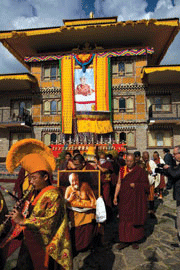 It was a time for devotees to show their reverence to their spiritual teacher, who, through his teachings, steered them clear of the path of sin.
It was a time for devotees to show their reverence to their spiritual teacher, who, through his teachings, steered them clear of the path of sin.
Besides, they were also given an opportunity through teachings they received to make atonement for sins they had committed in their younger days.
A one-time soldier, Rinchen Wangdi, admitted that he would have killed at least 100 wild animals and killed countless fishes when he was young.
“We were aggressive people and we wouldn’t have changed had it not been for Dilgo Khyentse rinpoche, whom we were fortunate to meet,” he said.
Rimpoche, he said, explained to them, referring to a group of ex-soldiers, who were assigned to be Dilgo Khyentse rimpoche’s personal attendants, why we need to be compassionate to all living beings and turned us into being more kind, loving and patient people.
“We were taught to kill,” said Norbu, 69, another ex-soldier, who served as Dilgo rinpoche’s personal attendant for three years. “But after we were taken under his wing, we could never think of killing.”
The group of ex-soldiers, along with other personal attendants, who had served the rinpoche, were yesterday recognised and presented statues during the first day of the centenary celebrations of Dilgo Khyentse rinpoche being held in Paro.
His Majesty the fourth Druk Gyalpo, Her Majesty the Grand Queen Mother Ashi Kesang Choden Wangchuck and members of the royal family, attended the event. Dilgo Khyentse rimpoche was the root teacher for the royal family.
Her Majesty the Grand Queen Mother Ashi Kesang Cheoden Wangchuck was also recognised for her support to Dilgo Khyentse rinpoche during the celebrations.
Also in attendance was Lyonchhoen Jigmi Y Thinley, several ministers and senior government officials, most of whom had at one time received teachings from or been associated with Dilgo Khyentse during his presence in Bhutan.
“Rinpoche never got angry in the seven years that I was with him,” said Dego, 71, also an ex-soldier, who became Dilgo Khyentse’s personal attendant. “Every morning he’d wake up at exactly 3 am and meditate until 8 am and, although we disturbed him by entering his room during meditation, he never got angry.”
Norbu said how difficult it was to understand the teachings of many rinpoches today, who sometimes gave incomplete teachings or transmissions. “Rinpoche’s teachings were always complete, and they were very clear,” he said.
“I regard him as the truest practitioner, a real Buddha,” added Dego, pointing out that Dilgo Khyentse, despite being Nyingma, could also teach according to the traditions of Kagyu, Gelug, and Sakya.
Dego also explained that his high regard for Dilgo Khyentse stems from the rinpoche’s experience of receiving most of his teachings within Tibet itself.
Dilgo Khyentse moved to Bhutan in 1959 and lived in Bhutan until his death in 1991.
Between those years, Dilgo Khyentse began teaching not only in Bhutan but also in India, Nepal, Southeast Asia, Europe and the USA. With such a reach, it was no surprise that nearly half of those attending the centenary celebrations being held at Satsam chorten in Paro were from abroad.
Dilgo Khyentse’s influence had been the same, despite the different cultural backgrounds of his students.
“I was a professional fisherman,” said Jean Pierre Devorsine, who had come all the way from France. Like the ex-soldiers, Dilgo Khyentse convinced the 58-year-old against killing. He devoted 30 years of his life to the teachings of Dilgo Khyentse.
Some, like Paivi Ahonen, from Finland, had never even met the rinpoche, yet through his published teachings, came to respect Dilgo Khyentse and followed him to the centenary celebrations.
The centenary celebrations, which end this Thursday, is open to the public.
Author : Gyalsten K Dorji
Source : http://www.kuenselonline.com




